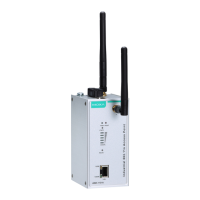AirWorks AWK-1131A Web Console Configuration
Time zone
Setting Description Factory Default
User selectable time
zone
The time zone setting allows conversion from
Mean Time) to local time.
GMT (Greenwich
Mean Time)
ATTENTION
Changing the time zone will automatically adjust the
Current local time. You should configure the Time
before setting the Current local time.
Daylight saving time
Setting Description Factory Default
Enable/ Disable
Daylight saving time (DST or summer time) involves advancing
clocks (usually 1 hour) during the summer time to provide an
extra hour of daylight in the afternoon.
Disable
When Daylight saving time is enabled, the following parameters will be shown:
• Starts at: The date that daylight saving time begins.
• Stops at: The date that daylight saving time ends.
• Time offset: Indicates how many hours forward the clock should be advanced.
Time server 1/2
Setting Description Factory Default
IP/Name of Time
Server 1/2
IP or Domain name of the NTP time server. The 2nd NTP server
will be used if the 1st NTP server fails to connect.
time.nist.gov
Time sync interval
Setting Description Factory Default
Time interval for NTP
server synchronization
(600 to 9999 seconds)
This parameter determines how often
from the NTP server.
600 (seconds)
Wireless LAN Setup
The AWK-1131A provides the AP/client mode for point-to-multipoint communication.
AP/client: The IP-Bridging mechanism is used to overcome limitations of the 802.11 standards. In this case,
the MAC address of the devices connected to the client radio will be replaced with the client’s MAC address.
Under AP/client modes, communication problems might be encountered when you have a MAC authenticated
system or MAC (Layer 2) based communication. In this case, you will need to change the network to use the
master/slave operation mode.
Sniffer: In order to provide an easier way for our customers to analyze wireless traffic, the AWK-1131A
supports a “Sniffer” mode to co-work with Wireshark packet sniffer software.
Although it is more convenient to use dynamic bridging, there is a limitation
—the Client can only transmit
-based packets between its wireless interface (WLAN) and Ethernet interface (LAN); other types of traffic
(such as IPX and AppleTalk) are not forwarded.

